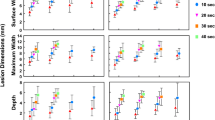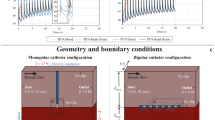Summary
In this study we compared the effects of radiofrequency (RF) energy applied to the swine endocardium in a unipolar fashion and in a bipolar one with two different interelectrode distances (5 mm, 10 mm). RF energy (500 kHz) delivered to the swine endocardium was divided into eight categories: 100 J, 101–200 J, 201–300 J, 301–400 J, 401–500 J, 501–600 J, 601–1000 J, and > 1000 J. The results showed that when RF energy was applied in a bipolar fashion, the lesions involved the catheter /tissue interface and partly the interelectrode spacing, while in a unipolar fashion. They were found in the catheter/tissue interface only. At any energy level, there were no statistically significant differences in lesion depths among all the three fashions, and the lesion surface areas produced by the bipolar fashion (with b mm or 10 mm interelectrode spacing) were all greater than those by the unipolar fashion (P< 0.05). When the delivered energy was under 500 joules, a greater lesion surface area was found in 5 rhm bipolar fashion than in 10mm bipolar fashion (P< 0.05), while energy exceeded 500 joules, the differences in the lesion surface areas were no longer significant between these two bipolar fashions.
Similar content being viewed by others
References
Jackman w, Kuch K H, Friday Ket al. Catheter recording of accessory atrioventricular pathway activation. Gardiac Electrophysiology: From cell to beside. Philadelphia: W B Saunders Co, 1990; 491
Roman C A, Wang X, Friday Ket al. Catheter technique for selectiveablation of slow pathway in AV nodal reentrant tachycardia (abstract). PACE, 1990; 13: 498
Michel Haissaguerre M D, Fiorenzo Gaita M D, Bruno Fischer M Det al. Elimination of atrioventricular nodal reentrant tachycardia using discrete slow potentials to guide application of radiofrequency energy. Circulation, 1992; 85 (6) 2162
Haines D E, Verow A F, The impedance rise during radiofrequency ablation in vivo is prevented by maintaining and electrode tip temperature below the boiling point (abstract). Circulation, 1989; 80: II-41
Jackman M D, Wang M D, Friday M Det al. Catheter ablation of atrioventricular junction using radiofrequency current in 17 patients: Comparison of standard and large-tip catheter electrodes. Circulation, 1991; 83 (5): 1562
Langberg J J, Lee M A, Chin M Cet al. Radiofrequency catheter ablation: The effect of electrode size on lesion volume in vivo. PACE, 1990; 13: 1242
Oeff M, Langberg J J, Chin M Cet al. Ablation of ventricula. tachycardia usin multiple sequencial transcatheter application of radiofrequency energy. PACE, 1992; 15: 1167
Kadish A H, Childs K, Schmaltz Set al. Differences in QRS configuration during unipolar pacing from adjacent sites: implications for the spatial resolution of pace-mapping. J AM Coll Cardiol, 1991; 17: 143
Waren Jackman M D, Kari-Heinz Kuch M D, Gerald Naccarelli M Det al. Catheter ablation at the mitral annulus using RF Current in canines. PACE, 1987; 10: 410
Author information
Authors and Affiliations
Rights and permissions
About this article
Cite this article
Yang-gan, W., Zai-ying, L., Hua-yue, Z. et al. A comparative study of radiofrequency ablation in unipolar and bipolar fashion. Journal of Tongji Medical University 15, 73–76 (1995). https://doi.org/10.1007/BF02887905
Received:
Issue Date:
DOI: https://doi.org/10.1007/BF02887905




